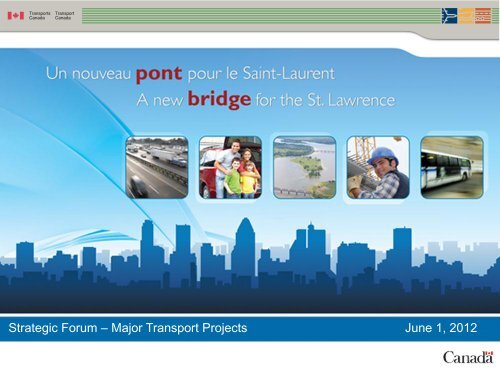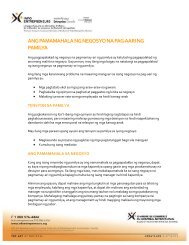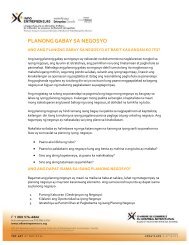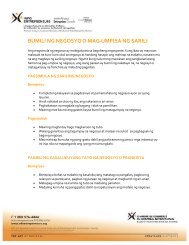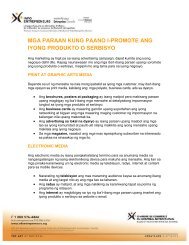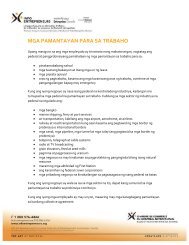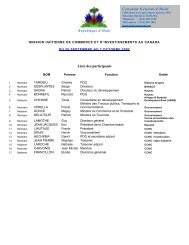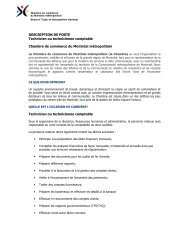A New Bridge for the St. Lawrence
A New Bridge for the St. Lawrence
A New Bridge for the St. Lawrence
Create successful ePaper yourself
Turn your PDF publications into a flip-book with our unique Google optimized e-Paper software.
<strong>St</strong>rategic Forum – Major Transport Projects June 1, 2012<br />
1
Objectives<br />
• Provide an overview of <strong>the</strong> project<br />
• Present <strong>the</strong> preliminary timeline<br />
• Describe <strong>the</strong> federal environmental assessment process<br />
• Explain <strong>the</strong> business case development process<br />
• Underline <strong>the</strong> importance of stakeholder involvement<br />
2
A <strong>New</strong> <strong>Bridge</strong> <strong>for</strong> <strong>the</strong> <strong>St</strong>. <strong>Lawrence</strong><br />
• On October 5, 2011, <strong>the</strong> Minister of Transport, Infrastructure and<br />
Communities, <strong>the</strong> Honourable Denis Lebel, announced <strong>the</strong><br />
construction of a <strong>New</strong> <strong>Bridge</strong> <strong>for</strong> <strong>the</strong> <strong>St</strong>. <strong>Lawrence</strong> to replace <strong>the</strong><br />
Champlain <strong>Bridge</strong>.<br />
• Transport Canada was given<br />
<strong>the</strong> mandate to assume <strong>the</strong><br />
governance of this project.<br />
• A public private partnership<br />
is <strong>the</strong> preferred option <strong>for</strong><br />
<strong>the</strong> construction, financing<br />
and operation of <strong>the</strong> new<br />
bridge.<br />
3
Existing Corridor<br />
• The Champlain <strong>Bridge</strong> is <strong>the</strong> busiest bridge in Canada.<br />
• Traffic and trade, per year<br />
– All vehicles : 60 millions<br />
– Trucks : 6.2 millions (10.4 % of<br />
vehicles crossing <strong>the</strong> bridge)<br />
– Bus : 200,000<br />
– Public transit users : 11 millions<br />
– International trade : 20 billion dollars<br />
• Many studies and reports were<br />
considered in <strong>the</strong> decision to<br />
build a new bridge.<br />
4
Pre-Feasibility <strong>St</strong>udy<br />
• The study examined different options <strong>for</strong> <strong>the</strong><br />
construction of a bridge or tunnel. It<br />
considered requirements <strong>for</strong> transportation<br />
and traffic, environmental aspects, methods<br />
of delivery as well as financial considerations.<br />
• The study favours <strong>the</strong> replacement of <strong>the</strong><br />
existing bridge by an eight-lane bridge,<br />
including two lanes dedicated to public<br />
transit.<br />
• The recommendations from <strong>the</strong> study will be<br />
used as <strong>the</strong> basis <strong>for</strong> <strong>the</strong> design of <strong>the</strong><br />
project.<br />
5
Components of <strong>the</strong> Project<br />
Component A – Reconstruction and widening of Highway 15<br />
Component B – <strong>New</strong> Nuns’ Island <strong>Bridge</strong><br />
Component C – Work on Nuns’ Island<br />
Component D – A <strong>New</strong> <strong>Bridge</strong> <strong>for</strong> <strong>the</strong> <strong>St</strong>. <strong>Lawrence</strong><br />
Component E – Alignment with Highway 10<br />
Component F – Demolition of Champlain <strong>Bridge</strong><br />
6
Component A - Reconstruction and<br />
Widening of Highway 15<br />
• The reconstruction and widening of Highway 15 will be done on <strong>the</strong> federal<br />
portion of Highway 15 between <strong>the</strong> Nuns’ Island <strong>Bridge</strong> and <strong>the</strong> Atwater Avenue<br />
exit/access.<br />
• A third lane in each direction is planned to provide continuity with <strong>the</strong> three lanes<br />
between <strong>the</strong> Turcot Interchange and <strong>the</strong> <strong>New</strong> <strong>Bridge</strong> <strong>for</strong> <strong>the</strong> <strong>St</strong>. <strong>Lawrence</strong>.<br />
• Work will also be required on several access ramps in <strong>the</strong> Atwater and Nuns’ Island<br />
<strong>Bridge</strong> areas.<br />
7
Component B –<br />
<strong>New</strong> Nuns’ Island <strong>Bridge</strong><br />
• The existing bridge between Nuns’ Island and <strong>the</strong> Island of Montreal will<br />
be replaced.<br />
• It is too early to confirm <strong>the</strong> final bridge design.<br />
8
Component C –<br />
Work on Nuns’ Island<br />
• Work on Nuns’ Island will consist of changes to Highway 10, to <strong>the</strong> access<br />
ramps of both <strong>the</strong> <strong>New</strong> <strong>Bridge</strong> <strong>for</strong> <strong>the</strong> <strong>St</strong>. <strong>Lawrence</strong> and <strong>the</strong> Nuns’ Island<br />
<strong>Bridge</strong>, and to local roads.<br />
• Access ramps to and from Nuns’ Island will also need to be aligned with<br />
<strong>the</strong> new bridge.<br />
• Additional work may also be required to accommodate public transit.<br />
9
Component D –<br />
A <strong>New</strong> <strong>Bridge</strong> <strong>for</strong> <strong>the</strong> <strong>St</strong>. <strong>Lawrence</strong><br />
• The <strong>New</strong> <strong>Bridge</strong> <strong>for</strong> <strong>the</strong> <strong>St</strong>. <strong>Lawrence</strong> will be located downstream from <strong>the</strong><br />
Champlain <strong>Bridge</strong>.<br />
• It will begin at Nuns’ Island (Montreal’s Verdun borough), cross <strong>the</strong> <strong>St</strong>. <strong>Lawrence</strong><br />
River and <strong>St</strong>. <strong>Lawrence</strong> Seaway, and will end in <strong>the</strong> City of Brossard on <strong>the</strong> South<br />
Shore. The pre-feasibility study indicates that <strong>the</strong> best design <strong>for</strong> <strong>the</strong> bridge would<br />
be three lanes in each direction <strong>for</strong> vehicles and <strong>the</strong> possibility of a fourth lane in<br />
each direction <strong>for</strong> public transit.<br />
• The bridge has three components :<br />
– Component D1a : crossing of <strong>the</strong> <strong>St</strong>. <strong>Lawrence</strong> River between Nuns’ Island and <strong>the</strong> Seaway;<br />
– Component D2 : crossing <strong>the</strong> Seaway; and<br />
– Component D1b : crossing of <strong>the</strong> navigable section between <strong>the</strong> Seaway and <strong>the</strong> Brossard shore. 10
Component E –<br />
Alignment with Highway 10<br />
• Highway 10 will need to be realigned with <strong>the</strong> <strong>New</strong> <strong>Bridge</strong> <strong>for</strong> <strong>the</strong><br />
<strong>St</strong>. <strong>Lawrence</strong>.<br />
• The existing bridge access ramps on <strong>the</strong> South Shore will also need to be<br />
slightly realigned to connect with Highway 10.<br />
11
Component F –<br />
Demolition of Champlain <strong>Bridge</strong><br />
• The demolition of <strong>the</strong> existing Champlain <strong>Bridge</strong> will likely proceed once<br />
<strong>the</strong> <strong>New</strong> <strong>Bridge</strong> <strong>for</strong> <strong>the</strong> <strong>St</strong>. <strong>Lawrence</strong> is built.<br />
• <strong>St</strong>. <strong>Lawrence</strong> Seaway operations and environmental restrictions will also<br />
need to be taken into account.<br />
12
Preliminary Timeline<br />
• The Pre-Feasibility <strong>St</strong>udy <strong>for</strong>esees that a period of ten years will be<br />
required be<strong>for</strong>e <strong>the</strong> new bridge can be in service, which includes <strong>the</strong> time<br />
required <strong>for</strong> <strong>the</strong> environmental assessment, <strong>the</strong> design, <strong>the</strong> engineering<br />
and <strong>the</strong> construction. The demolition of <strong>the</strong> existing bridge will follow.<br />
Preliminary Timetable - <strong>New</strong> <strong>Bridge</strong> <strong>for</strong> <strong>the</strong> <strong>St</strong>. <strong>Lawrence</strong><br />
HIGH LEVEL COMPONENTS<br />
Environmental Assessment<br />
Preliminary design and financial analysis<br />
Preliminary engineering and development of specifications<br />
Invitation to tender <strong>for</strong> construction and contract award<br />
Final plans and specifications and construction (by bridge constructor)<br />
Demolition of <strong>the</strong> old bridge (by bridge constructor)<br />
2012 2013 2014 2015 2016<br />
2017 2018 2019 2020 2021 2022 2023 2024<br />
* This is a preliminary timeline that will be refined over <strong>the</strong> coming months.<br />
• Ways of shortening this timeline without affecting <strong>the</strong> quality of <strong>the</strong> work<br />
will be considered.<br />
13
Environmental Assessment<br />
• The federal environmental assessment was launched on January 22, 2012.<br />
• Given that certain project parameters are not yet defined, <strong>the</strong> approach<br />
adopted <strong>for</strong> <strong>the</strong> environmental assessment will allow <strong>for</strong> mitigation<br />
measures to be issued as objectives. These mitigation measures will be<br />
integrated into <strong>the</strong> project specifications.<br />
• Following a request <strong>for</strong> proposals, <strong>the</strong><br />
Dessau|Cima+ Consortium was selected<br />
to conduct <strong>the</strong> environmental assessment.<br />
• Public consultations related to <strong>the</strong><br />
environmental assessment are planned<br />
between Fall 2012 and Spring 2013.<br />
• The environmental assessment should be<br />
completed within 18 months.<br />
14
Development of <strong>the</strong> Business Case<br />
• On March 30, 2012, Transport Canada launched an important<br />
request <strong>for</strong> proposals to retain expert financial, technical and<br />
engineering services.<br />
• The request’s objectives are to :<br />
– Develop a business case and contribute to project planning;<br />
– Establish traffic and revenue <strong>for</strong>ecasts; and<br />
– Undertake preliminary design and costing work.<br />
• The request was posted on MERX, <strong>the</strong> website <strong>for</strong> Canadian<br />
government procurement, until May 31 st , 2012.<br />
• This phase should be completed within 18 months.<br />
15
Business Case – Components<br />
Component 1 : Development of <strong>the</strong> Business Case and Project Planning<br />
• Assist Transport Canada with <strong>the</strong> overall integrated planning of <strong>the</strong> project.<br />
• Develop <strong>the</strong> business case, including a value-<strong>for</strong> money assessment and an<br />
evaluation of potential public-private partnership models, in order to identify <strong>the</strong><br />
optimal procurement strategy to design, build, finance, operate and maintain <strong>the</strong><br />
new bridge corridor.<br />
Component 2 : Traffic and Revenue Forecasts<br />
• Establish <strong>the</strong> traffic and revenue <strong>for</strong>ecasts that will be used to develop <strong>the</strong><br />
business case, including potential toll revenues that could be generated.<br />
Component 3 : Preliminary Design and Costing<br />
• Validate <strong>the</strong> conclusions of <strong>the</strong> prefeasibility studies on <strong>the</strong> replacement of <strong>the</strong><br />
Champlain <strong>Bridge</strong>, <strong>the</strong> Nuns’ Island <strong>Bridge</strong> and Highway 15 and confirm <strong>the</strong><br />
modifications needed to <strong>the</strong> connections to <strong>the</strong> existing road network.<br />
• Provide cost estimates (Class “D”) of <strong>the</strong> expected design and construction work<br />
<strong>for</strong> each of <strong>the</strong> options studied.<br />
16
<strong>St</strong>akeholder Engagement<br />
• Concurrent to <strong>the</strong> completion of <strong>the</strong> studies, frequent<br />
meetings with project stakeholders will be held to ensure<br />
close coordination.<br />
• Advisory Committees will be established to ensure <strong>for</strong>mal<br />
collaboration between key stakeholders, including:<br />
– A strategic committee comprised of organizations whose territory<br />
and/or jurisdiction is directly affected by <strong>the</strong> project;<br />
– Technical committees to manage specific components of <strong>the</strong> project<br />
such <strong>the</strong> environment or engineering.<br />
17
Next <strong>St</strong>eps<br />
• Transport Canada will continue <strong>the</strong> essential preliminary work to<br />
advance <strong>the</strong> project, including :<br />
– Meetings with stakeholders affected by <strong>the</strong> project will continue on a regular<br />
basis.<br />
– The selection of a firm to carry out <strong>the</strong> business case is planned <strong>for</strong> <strong>the</strong> end of<br />
June.<br />
– The federal environmental assessment should be completed within 18<br />
months.<br />
• For more in<strong>for</strong>mation on <strong>the</strong> project, please consult <strong>the</strong> <strong>New</strong> <strong>Bridge</strong> <strong>for</strong><br />
<strong>the</strong> <strong>St</strong>. <strong>Lawrence</strong> section on Transport Canada’s website :<br />
www.tc.gc.ca/nbfsl<br />
18


